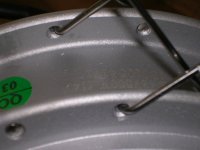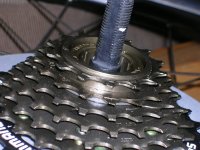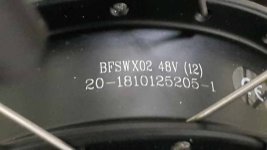Herrsprocket
100 W
Greetings all,
I'm not sure if BMS battery itself understands its own code ratings and voltages for the BPM motors but simply passes along the information as given to them from managerial marketing. Regardless, many months ago I too wanted to de-confuse the code ratings so I could better understand exactly the performance values and code reasoning for any particular motor. So I began a communication directly with Bafang and they were extremely informative, courteous and helpful. The coding actually from Bafang is quite simple. It seems however, that BMS battery tends to muddy the waters by simply filling in different market needs with a variety of voltages, windings and wheel sizes. This marketing ploy from BMS battery is understandable and does help satisfy a wide spectrum of performance values, but unless you know the basics of how the motors are coded directly from Bafang, you'll be scratching your head like most of us have.
Firstly, the two BPM models and the new CST cassette hub model are all rated at 36 V. The coding applies to a 36 V input and all the values I will be giving you are in unloaded conditions. Let's begin with a code 16 motor and work our way up to the code 8 motor.
The code 16 motor is rated at 192 RPM. The code 15 is 205. The code 14 is 215. The code 13 is 230. The code 12 is 250. The code 11 is 280. The code 10 is 300. The code 9 is 335. And the code 8 is 378. That's right, the code 8 at 36 V is not 393 RPM but is 378. Again, mind you all of these specifications are directly from the engineers of Bafang.
And thus the game begins. The closest proximity I can muster for the difference between a 36 V and a 48 V system is simply to take the code rating at 36 V and multiply it by a factor of 133% for an approximate unloaded speed at 48 V. This is not an exact science but it's fairly close for our unloaded guesstimations. As an example, you will see that BMS battery lists a 48 V BPM model with a 393 RPM output. This is simply a 36 V rated motor with a code 10 winding that is being over volted to 48 V and will now spin at an unloaded speed of approximately 399 RPMs, or as they list, 393 RPMs. The number they list prior to the code value (which is the first number listed on the motor) is a suggested wheel size in which to put this rated voltage and coded motor into to reach a particular miles per hour value. This is confusing. You simply need to know how fast your motor is spinning with its particular voltage and code rating and then figure out how fast in miles per hour it will go with the particular wheel size that you select. Obviously, the higher code windings will give you more torque and less RPM unloaded speeds and might be better suited for larger wheels. However, it's up to you to decide whatever blows your skirt up to get the performance you want.
As TD says," have a nice day".
I'm not sure if BMS battery itself understands its own code ratings and voltages for the BPM motors but simply passes along the information as given to them from managerial marketing. Regardless, many months ago I too wanted to de-confuse the code ratings so I could better understand exactly the performance values and code reasoning for any particular motor. So I began a communication directly with Bafang and they were extremely informative, courteous and helpful. The coding actually from Bafang is quite simple. It seems however, that BMS battery tends to muddy the waters by simply filling in different market needs with a variety of voltages, windings and wheel sizes. This marketing ploy from BMS battery is understandable and does help satisfy a wide spectrum of performance values, but unless you know the basics of how the motors are coded directly from Bafang, you'll be scratching your head like most of us have.
Firstly, the two BPM models and the new CST cassette hub model are all rated at 36 V. The coding applies to a 36 V input and all the values I will be giving you are in unloaded conditions. Let's begin with a code 16 motor and work our way up to the code 8 motor.
The code 16 motor is rated at 192 RPM. The code 15 is 205. The code 14 is 215. The code 13 is 230. The code 12 is 250. The code 11 is 280. The code 10 is 300. The code 9 is 335. And the code 8 is 378. That's right, the code 8 at 36 V is not 393 RPM but is 378. Again, mind you all of these specifications are directly from the engineers of Bafang.
And thus the game begins. The closest proximity I can muster for the difference between a 36 V and a 48 V system is simply to take the code rating at 36 V and multiply it by a factor of 133% for an approximate unloaded speed at 48 V. This is not an exact science but it's fairly close for our unloaded guesstimations. As an example, you will see that BMS battery lists a 48 V BPM model with a 393 RPM output. This is simply a 36 V rated motor with a code 10 winding that is being over volted to 48 V and will now spin at an unloaded speed of approximately 399 RPMs, or as they list, 393 RPMs. The number they list prior to the code value (which is the first number listed on the motor) is a suggested wheel size in which to put this rated voltage and coded motor into to reach a particular miles per hour value. This is confusing. You simply need to know how fast your motor is spinning with its particular voltage and code rating and then figure out how fast in miles per hour it will go with the particular wheel size that you select. Obviously, the higher code windings will give you more torque and less RPM unloaded speeds and might be better suited for larger wheels. However, it's up to you to decide whatever blows your skirt up to get the performance you want.
As TD says," have a nice day".






